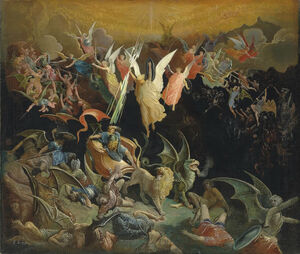Demon (Greek: δαίμων, daimon) often denotes a malevolent entity in classical and modern cultures and religions. However, its Greek root, daimon, may not have necessarily carried any negative connotations.[5] Daimon originally implied a spirit or divine power, possibly an equivalent to the Latin word numen,[6] meaning "divinity", or a "divine presence", "divine will."[7] At the advent of Christianity, Greek and Latin concepts were paganized, or essentially, demonized.[8]
Ancient aliens
One of the most ancient written sources regarding a clash between good and evil is the Enuma Elis which recounts Mesopotamian cosmology. A great beast is described, known as Tiamat, who bears children to serve in her rebellion against Marduk (Babylonian), or EA (Sumerian). Tiamat was described as primordial chaos [9] and sometimes identified with images of a sea serpent or dragon.[10] The Enûma Elish states that Tiamat gave birth to dragons and serpents, among a more general list of monsters including scorpion men and merpeople.[11] Such iconography had impressed Greek mythology as well as eschatology in Judeo-Christian theology. It is also a deep study in demonology as well as for developing support for the ancient aliens hypothesis.
Zecharia Sitchin, an advocate of the ancient aliens hypothesis, ran with these early concepts to promote his Tiamat hypothesis which states that Nibiru (a name synonymous with MARDUK) collided catastrophically with a planet, Tiamat, once located between Mars and Jupiter. This collision supposedly formed the planet Earth, the asteroid belt, and the comets.[12][13][14]
Popular culture

The Fall of the Rebel Angels by Gustave Doré
- "Blue Demons" from Galaxy Quest.
- Daemons from Doctor Who.
- Devaronians from Star Wars are said to resemble demons.
- Demons from DOOM.
- Demons from Hellgate: London.
- Maelibi, a.k.a. "Demons" from Star Wars.
- Parademons from DC.
- Queller Demons from Buffy the Vampire Slayer.
- The Scourge from Doctor Who.
- Daemons from Warhammer 40,000.
See also
Sources
- ↑ California State University, The Enuma Elish (PDF) (short version)
- ↑ Hinduism: The Ideas of Heaven and Hell, by Swami Adiswarananda
- ↑ Giants Of Sumer, by Xavier Séguin, March 8, 2014
- ↑ Encyclopedia Judaica: Anthropomorphism
- ↑ Liddell, Henry George; Scott, Robert. "δαιμόνιον". A Greek–English Lexicon. Perseus.
- ↑ "Demon". Merriam-Webster Dictionary. Encyclopædia Britannica.
- ↑ Charlton T. Lewis, Charles Short, A Latin Dictionary
- ↑ Arnold Angenendt, “The Christianization of Latin Europe”, Brill’s Encyclopedia of the Middle Ages
- ↑ Dalley, Stephanie (1987). Myths from Mesopotamia. Oxford University Press. pp. 329.
- ↑ Jacobsen, Thorkild (1968). "The Battle between Marduk and Tiamat". Journal of the American Oriental Society 88 (1): 104–108. doi:10.2307/597902.
- ↑ King, Leonard William (1902). The Seven Tablets of Creation (Vol. II: Supplementary Texts). pp. 117.
- ↑ Wikipedia, Zecharia Sitchin, Ideas and works
- ↑ Sitchin, Zecharia (1990). "Chapter 2: It Came From Outer Space". Genesis Revisited. New York: Avon Books. ISBN 0380761599.
- ↑ Compare to Phaeton (hypothetical planet)
Resources
- Exopolitics, Tiamat
- UFO-alien database, Tiamatians